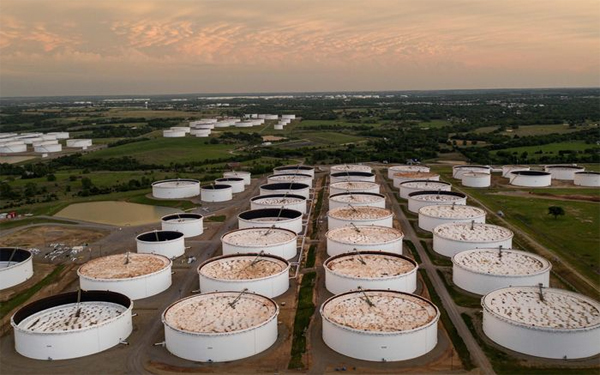
Mayra P. Saefong, William Watts, MarketWatch
SAN FRANCISCO/NEW YORK
EnergiesNet.com 06 30 2022
Oil futures settled lower on Wednesday, easing back after three consecutive session gains, even as a more than three million-barrel drop in U.S. crude supplies over the past two weeks fed concerns over tight global inventories.
Price action
- West Texas Intermediate crude for August delivery CL.1, -0.73% CL00, -0.71% CLQ22, -0.73% fell $1.98, or 1.8%, to settle at $109.78 a barrel on the New York Mercantile Exchange.
- The front month the global benchmark August Brent crude contract CLQ22, -0.73% shed $1.72, or 1.5%, to $116.26 a barrel on ICE Futures Europe. The most active September Brent crude contract BRN00, -0.54% BRNU22, -0.54% lost $1.35, or 1.2%, to end at $112.45 a barrel.
- Back on Nymex, July gasoline RBN22, -3.37% fell nearly 2.8% to $3.827 a gallon.
- July heating oil HON22, 0.08% shed 3.9% to $4.0367 a gallon.
- August natural gas NGQ22, -0.35% lost 1.1% to $6.498 per million British thermal units.
Market drivers
Crude prices had climbed for three sessions in a row, with support tied to strong underlying demand and tightening supplies, before settling lower on Wednesday.
Tariq Zahir, managing member at Tyche Capital Advisors, attributed the pull back in prices to some profit-taking, following the recent price moves higher.
Prices had seen an early boost, driven by China’s moves to ease COVID restrictions, continued worries about tight supplies and a constrained outlook for production increases, analysts said, though fears of recession remained, as the Federal Reserve and other major central banks tighten monetary policy aggressively in an effort to rein in inflation.
The Organization of the Petroleum Exporting Countries held a meeting Wednesday, ahead of a broader gathering of OPEC members and their allies, known as OPEC+, on Thursday. The Wall Street Journal reported some delegates said OPEC discussed administrative matters at Wednesday’s meeting.
OPEC+ is expected to confirm an already agreed supply increase of 648,000 barrels a day in output for August.
“However, as we have seen in recent months, it is highly unlikely that the group will be able to boost supply by this amount, given the limited spare capacity amongst members and the expectation that Russian oil output will decline as we move closer to the [European Union’s] ban on Russian seaborne crude oil imports,” said Warren Patterson, head of commodities strategy at ING, in a note.
Traders also eyed indirect talks between Iran and the U.S. being held this week in Qatar in an effort to revive Tehran’s nuclear deal.
Supply data
The Energy Information Administration on Wednesday released data showing declines in U.S. crude supplies in the past two weeks, totaling more than three 3 million barrels, excluding oil from Strategic Petroleum Reserve.
Data covering the week ended June 17, which the EIA had delayed due to “systems issues,” revealed a fall to 418.3 million barrels in crude supplies, from 418.7 million barrels the week before, implying a decline of roughly 400,000 barrels.
Data for the week ended June 24 showed a fall of 2.8 million barrels to 415.6 million barrels, compared with an average decrease of 500,000 barrels forecast by analysts polled by S&P Global Commodity Insights. The report also showed increases of 2.6 million barrels each for supplies of gasoline and distillates for the week ended June 24. Survey forecasts for declines of 875,000 and 525,000 barrels for gasoline and distillates, respectively.
Increases in refining margins reflect demand and if demand is high, “it will cause the refiners to run more,” said Phil Flynn, senior market analyst at The Price Futures Group. “The problem of course is that we still have limited refining capacity, global oil supplies are too low and we still have the risk of tropical weather in the Atlantic that could create even more havoc for the global oil market.”
The EIA reported that crude stocks in the SPR dropped by 7 million to 497.9 million barrels last week, while stocks at the Cushing, Okla., Nymex delivery hub edged down by 700,000 barrels.
The SPR is now below 500 million barrels for the first time since 1986, said Matt Smith, lead oil analyst, Americas, at Kpler. However, U.S. oil production ticked higher to 12.1 million barrels a day, the highest since April 2020, he told MarketWatch.
The American Petroleum Institute reported late Tuesday that U.S. crude supplies declined by 3.8 million barrels for the week ended June 24.
Overall, crude has started to drift higher in recent days and the risk is likely to the upside in the energy markets, said Tyche Capital’s Zahir.
When China began lifting COVID restrictions, that’s when oil saw its recent strength, he said. “We are also in [Atlantic] hurricane season and [there are] recent reports that Saudi Arabia has little capacity to bring on immediately.”
marketwatch.com 06 29 2022











